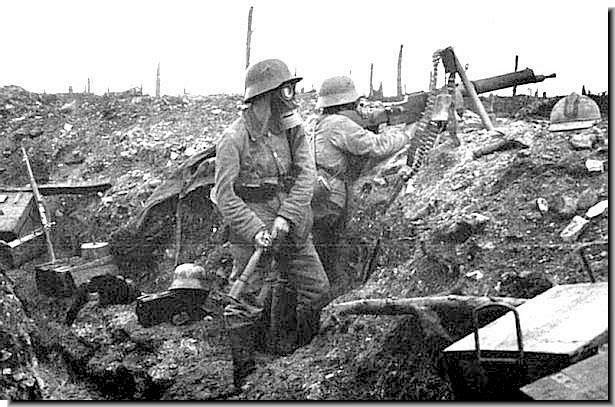

Forests were reduced to tangled piles of wood. The massive amount of artillery tore up the ground turning it into a wasteland of mud pools when the rain came. Many troops at the battle never saw an enemy soldier, experiencing nothing but artillery fire. So many shells were fired that the top of one particular hill vanished. Over the course of the next eleven months, the two armies fired an estimated 65 million artillery shells at one another that not only decimated both armies but completely devastated the land. Supported by 1,200 artillery guns, they blasted hundreds of thousands of shells at the Verdun region. On the first day alone, the Germans sent 140,000 soldiers to attack the French town. The battlefield of Verdun scarred with shell craters. His plan was not to capture the city, but simply to kill as many Frenchmen as possible, or to quote him, “bleed the French army white”.

Falkenhayn believed that France would fight for this piece of land to the last man, and by doing so would lose so many men that the battle would change the course of the war. Falkenhayn knew that the French simply could not allow these forts to fall into the hands of the enemy because of the national humiliation that would follow. The area around Verdun contained twenty major forts and forty smaller ones that had historically protected the eastern border of France for centuries. Verdun wasn’t strategically important to the Germans, but had a historic sentiment for the French. The attack on Verdun came about because of a cunning plan by the German Chief of General Staff, von Falkenhayn. The Battle of Verdun lasted over 300 days from 21 February 1916 until 19 December 1916 and caused an estimated casualty of over 700,000 dead, wounded and missing. A corpse was afloat in it his blackĬountenance face down in the water and his abdomen swollen as if he had beenįilling himself up with water for days now.One of the longest and deadliest battle of the First World War was fought over a small parcel of land in north-eastern France, near the commune and town of Verdun. Soldier was going insane with thirst and drank from a pond covered with a These shell holes would be full of muddied water, blood, grime and even bloated corpses as a German soldier says in his account " One Some soldiers, as the source suggests, quenched their thirst from shell holes. Thirst with water from the shellholes." This gives an idea about the sort of foods men were supposed to eat but also shows that soldiers were forced to use up emergency rations and were drastically underfed.

In the latter part of the battle, there were huge food shortages and one German officer stated in his diary " Because of the failing provisioning the men areįorced to use up their emergency rations of salty meats. This was particularly an issue at the battle of Verdun partially because it was such a long battle. These muddy conditions were common at both Verdun and Passchendaele. This mud was also extremely unhygienic often mixed with human waste and infested with rats. Because of this, thousands of soldiers could not be found lost in the mud and were put under the category of 'missing, presumed dead'. Wounded soldiers who fell in to the mud often drowned in it due to the extreme thickness of it trapping soldiers within it. These muddy conditions meant that advancement was very slow with soldiers sometimes taking over 3 hours to travel 100 metres! Soldiers, when 'going over the top', not only faced machine gun fire whilst running towards enemy trenches but had to run through this mud, often getting stuck or going through it very slowly. These conditions negatively affected the strategies that both armies were planning. heavy rain and wind) resulted in huge amounts of high density mud. As a result of consistent artillery bombardments throughout both the battles of Verdun and Passchendaele in combination with extremely poor weather conditions (i.e.


 0 kommentar(er)
0 kommentar(er)
